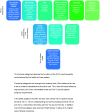The NICE Evidence Standards Framework for digital health and care technologies - Developing and maintaining an innovative evidence framework with global impact
- PMID: 34249371
- PMCID: PMC8236783
- DOI: 10.1177/20552076211018617
The NICE Evidence Standards Framework for digital health and care technologies - Developing and maintaining an innovative evidence framework with global impact
Abstract
Objective: In 2018, the UK National Institute for Health and Care Excellence (NICE), in partnership with Public Health England, NHS England, NHS Improvement and others, developed an evidence standards framework (ESF) for digital health and care technologies (DHTs). The ESF was designed to provide a standardised approach to guide developers and commissioners on the levels of evidence needed for the clinical and economic evaluation of DHTs by health and care systems.
Methods: The framework was developed using an agile and iterative methodology that included a literature review of existing initiatives and comparison of these against the requirements set by NHS England; iterative consultation with stakeholders through an expert working group and workshops; and questionnaire-based stakeholder input on a publicly available draft document.
Results: The evidence standards framework has been well-received and to date the ESF has been viewed online over 55,000 times and downloaded over 19,000 times.
Conclusions: In April 2021 we published an update to the ESF. Here, we summarise the process through which the ESF was developed, reflect on its global impact to date, and describe NICE's ongoing work to maintain and improve the framework in the context for a fast moving, innovative field.
Keywords: Health economics; clinical evidence; digital health; general; health technology assessment.
© The Author(s) 2021.
Conflict of interest statement
Declaration of conflicting interests: The author(s) declared the following potential conflicts of interest with respect to the research, authorship, and/or publication of this article: HU, BD, HP, MS, TO, LA, GS, JH, MC, FG, JP and AT all declare employment by NICE (HU until October 2020; MC until March 2019; FG from September 2020). LC was on placement at NICE as a public health specialty registrar. IJ is employed by NHSX. JP also receives funding from the National Institute for Health Research (NIHR) Collaboration for Leadership in Applied Health Research and Care Oxford at Oxford Health NHS Foundation Trust. The views expressed are those of the authors and not necessarily those of NICE, the NHS or NHS England, the NIHR or the Department of Health and Social Care.
Figures
References
-
- Ferretti A, Ronchi E, Vayena E. From principles to practice: benchmarking government guidance on health apps. Lancet Digit Health 2019; 1: e55–e57. - PubMed
-
- Bates DW, Landman A, Levine DM. Health apps and health policy. What is needed? JAMA 2018; 320: 1975–1976. - PubMed
-
- Torous J, Firth J, Huckvale K, et al.. The emerging imperative for a consensus approach toward the rating and clinical recommendation of mental health apps. J Nerv Ment Dis 2018; 206: 662–666. - PubMed
LinkOut - more resources
Full Text Sources
Miscellaneous


